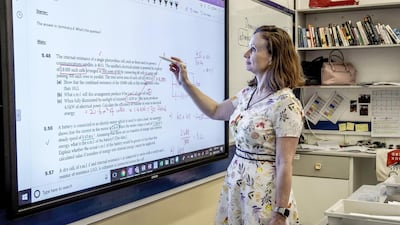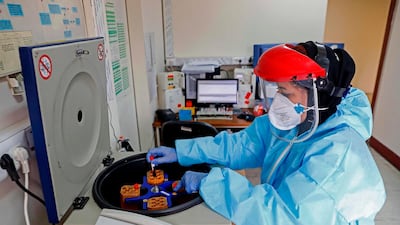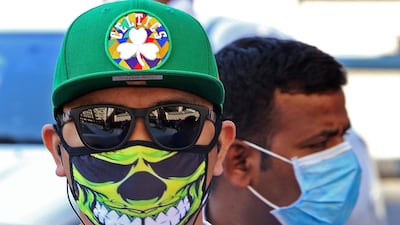Four months before the first novel coronavirus case was diagnosed in Wuhan, top investors, public health officials and academics in the United States laid out a case for how technology could help quicken the pace of forecasting the path of disease outbreaks.
The article, published in Nature in September last year, summarised why there is still a long way to go before forecasting can significantly improve epidemic management and reduce the economic impact of new infections such as Covid-19.
While there are still "major limitations" to forecasting outbreaks, existing and emerging technologies do have the potential to improve upon the status quo, according to the lead authors of the piece, Dylan George, a vice president at In-Q-Tel, the CIA's non-profit innovation investor, and Wendy Taylor, a Rockefeller Foundation fellow.
They shared a byline with academics from Johns Hopkins University, the University of Massachusetts Amherst and Columbia University, and public health officials from the Centres for Disease Control and Prevention.
"Infectious diseases forecasting can help predict seasonal epidemics and future pandemics in terms of timing and magnitude," Dr Ahmad Nusair, a physician in the infectious diseases unit at Cleveland Clinic Abu Dhabi, told The National.
If those forecasts are accurate, they can assist public health efforts to prevent or contain the spread of disease, he said.
But for new infections “that we are just beginning to learn about, the task is much more difficult as there are no historical outbreaks to model a prediction”.
Such mathematical models consider how disease is transmitted, how seasonal an illness is and surveillance data for population movements, Dr Nusair said.
Diseases like influenza “that have been around for a long time” are easier to forecast because healthcare workers are confident in how they are transmitted, the time it takes for symptoms to start and for how long, and the likelihood that a sick patient will recover.
For Covid-19, “this is a virus that is new to us”, Dr Nusair said.
“We are learning about its behaviour and how it affects us more and more every day.
"Given current available information, we predict that the virus will continue to spread globally possibly for months to come.”
The quantity, quality and timeliness of public health data is the most significant challenge, according to Mr George and Ms Taylor.
"Data collection can be a slow process, particularly in low-resource settings lacking sufficiently trained staff, with sporadic communications, limited healthcare systems and inconsistent electrical power," they wrote.
"Improving collection systems and advancing forecasting approaches that address these limitations and leverage existing surveillance data are necessary.".
Cleaning up that data once it is collected is also still too reliant on manual processes and they called for technologies that can do the task.
Sharing data is also “a problem”. While public health agencies often provide data and reports on their websites, they are often formatted in a way that “cause challenges for quantitative analysts”, making forecast modelling difficult.
“Reports are provided with a considerable time lag, and are not machine-readable nor provided in standard formats with metadata. This impedes sharing and use of these data,” the authors wrote.
However, the 2014-2015 West Africa Ebola outbreak marked a “paradigm shift” that resulted in a new embrace of open-science approaches to rapidly sharing data, they wrote.
Epidemiologists and forecast modellers have since begun using publicly available repositories, such as Microsoft’s GitHub, to aggregate and share digitised data in standardised formats.
Meanwhile, academic research on infectious disease forecasting has grown and models have successfully generated predictions for pathogens such as influenza, dengue, zika and ebola.
But so far the academic research is not yet reaching public health decision-makers in real time, according to the authors, and has “received little attention and relatively scarce resources”.
In the case of Covid-19, Dr Nusair said the rate of its spread will depend largely on the ability to identify and isolate patients, the practice of "good hygiene at all times" by the public and the close monitoring of traffic in and out of regions that are hit hard by the virus.
Dengue%20fever%20symptoms
%3Cul%3E%0A%3Cli%3EHigh%20fever%3C%2Fli%3E%0A%3Cli%3EIntense%20pain%20behind%20your%20eyes%3C%2Fli%3E%0A%3Cli%3ESevere%20headache%3C%2Fli%3E%0A%3Cli%3EMuscle%20and%20joint%20pains%3C%2Fli%3E%0A%3Cli%3ENausea%3C%2Fli%3E%0A%3Cli%3EVomiting%3C%2Fli%3E%0A%3Cli%3ESwollen%20glands%3C%2Fli%3E%0A%3Cli%3ERash%3C%2Fli%3E%0A%3C%2Ful%3E%0A%3Cp%3EIf%20symptoms%20occur%2C%20they%20usually%20last%20for%20two-seven%20days%3C%2Fp%3E%0A
THE SPECS
Engine: 1.5-litre turbocharged four-cylinder
Transmission: Constant Variable (CVT)
Power: 141bhp
Torque: 250Nm
Price: Dh64,500
On sale: Now
More from Neighbourhood Watch:
How does ToTok work?
The calling app is available to download on Google Play and Apple App Store
To successfully install ToTok, users are asked to enter their phone number and then create a nickname.
The app then gives users the option add their existing phone contacts, allowing them to immediately contact people also using the application by video or voice call or via message.
Users can also invite other contacts to download ToTok to allow them to make contact through the app.
The%20specs%20
%3Cp%3E%3Cstrong%3EEngine%3A%20%3C%2Fstrong%3E2.0-litre%204cyl%20turbo%0D%3Cbr%3E%3Cstrong%3EPower%3A%20%3C%2Fstrong%3E261hp%20at%205%2C500rpm%0D%3Cbr%3E%3Cstrong%3ETorque%3A%20%3C%2Fstrong%3E400Nm%20at%201%2C750-4%2C000rpm%0D%3Cbr%3E%3Cstrong%3ETransmission%3A%20%3C%2Fstrong%3E7-speed%20dual-clutch%20auto%0D%3Cbr%3E%3Cstrong%3EFuel%20consumption%3A%20%3C%2Fstrong%3E10.5L%2F100km%0D%3Cbr%3E%3Cstrong%3EOn%20sale%3A%20%3C%2Fstrong%3ENow%0D%3Cbr%3E%3Cstrong%3EPrice%3A%20%3C%2Fstrong%3EFrom%20Dh129%2C999%20(VX%20Luxury)%3B%20from%20Dh149%2C999%20(VX%20Black%20Gold)%3C%2Fp%3E%0A
White hydrogen: Naturally occurring hydrogen
Chromite: Hard, metallic mineral containing iron oxide and chromium oxide
Ultramafic rocks: Dark-coloured rocks rich in magnesium or iron with very low silica content
Ophiolite: A section of the earth’s crust, which is oceanic in nature that has since been uplifted and exposed on land
Olivine: A commonly occurring magnesium iron silicate mineral that derives its name for its olive-green yellow-green colour
The team
Videographer: Jear Velasquez
Photography: Romeo Perez
Fashion director: Sarah Maisey
Make-up: Gulum Erzincan at Art Factory
Models: Meti and Clinton at MMG
Video assistant: Zanong Maget
Social media: Fatima Al Mahmoud
Empires%20of%20the%20Steppes%3A%20A%20History%20of%20the%20Nomadic%20Tribes%20Who%20Shaped%20Civilization
%3Cp%3E%3Cstrong%3EAuthor%3A%20%3C%2Fstrong%3EKenneth%20W%20Harl%3Cstrong%3E%3Cbr%3EPublisher%3A%20%3C%2Fstrong%3EHanover%20Square%20Press%3Cstrong%3E%3Cbr%3EPages%3A%20%3C%2Fstrong%3E576%3C%2Fp%3E%0A
Monster
Directed by: Anthony Mandler
Starring: Kelvin Harrison Jr., John David Washington
3/5
F1 drivers' standings
1. Lewis Hamilton, Mercedes 281
2. Sebastian Vettel, Ferrari 247
3. Valtteri Bottas, Mercedes 222
4. Daniel Ricciardo, Red Bull 177
5. Kimi Raikkonen, Ferrari 138
6. Max Verstappen, Red Bull 93
7. Sergio Perez, Force India 86
8. Esteban Ocon, Force India 56
Notable Yas events in 2017/18
October 13-14 KartZone (complimentary trials)
December 14-16 The Gulf 12 Hours Endurance race
March 5 Yas Marina Circuit Karting Enduro event
March 8-9 UAE Rotax Max Challenge
Company profile
Name: Dukkantek
Started: January 2021
Founders: Sanad Yaghi, Ali Al Sayegh and Shadi Joulani
Based: UAE
Number of employees: 140
Sector: B2B Vertical SaaS(software as a service)
Investment: $5.2 million
Funding stage: Seed round
Investors: Global Founders Capital, Colle Capital Partners, Wamda Capital, Plug and Play, Comma Capital, Nowais Capital, Annex Investments and AMK Investment Office
Avatar: Fire and Ash
Director: James Cameron
Starring: Sam Worthington, Sigourney Weaver, Zoe Saldana
Rating: 4.5/5
In numbers: PKK’s money network in Europe
Germany: PKK collectors typically bring in $18 million in cash a year – amount has trebled since 2010
Revolutionary tax: Investigators say about $2 million a year raised from ‘tax collection’ around Marseille
Extortion: Gunman convicted in 2023 of demanding $10,000 from Kurdish businessman in Stockholm
Drug trade: PKK income claimed by Turkish anti-drugs force in 2024 to be as high as $500 million a year
Denmark: PKK one of two terrorist groups along with Iranian separatists ASMLA to raise “two-digit million amounts”
Contributions: Hundreds of euros expected from typical Kurdish families and thousands from business owners
TV channel: Kurdish Roj TV accounts frozen and went bankrupt after Denmark fined it more than $1 million over PKK links in 2013


















